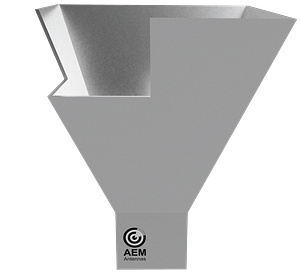It’s well known that horn antennas are tough to beat for for their directional patterns, wideband performance, low losses, and high efficiency. Horns are used as reflector feeds for their ability to focus energy on the reflector to minimize spillover and increase efficiency. This article will explore different horn antenna options to help you select the best performance for your application.

📄 Posted: 2024-10-21 12:05:56
✔️ Updated: 2024-10-21 13:29:23
Introduction
Horn antennas are a unique and versatile class of directional antennas that play an important role in various applications. They typically provide high gain, low loss, and unidirectional radiation patterns, these waveguide-based structures have been fundamental in enabling reliable and efficient data transmission in satellite communication networks. In this article, we explore horn options, feed integration, antenna optimization, and cost control.
For a more fundamental look at antenna characteristic terminology, see our article on Basic Antenna Parameters.
Design Elements & Types
The primary components of a horn antenna include a metallic waveguide, flaring metal surfaces (flare), and an aperture through which radio waves propagate. The flared shape is responsible for transforming the guided electromagnetic wave into free space while maintaining minimal losses. By controlling the dimensions of the flare angle and aperture size, engineers can tailor the radiation pattern and directivity to meet specific requirements.
Horn Models
We will explore a variety of horns including pyramidal, sectoral, spline conical, radially corrugated conical, and axially corrugated. Each horn antenna is used in various use-cases including global satellite antennas, reflector feeds, standard gain horns for measurement, radar, and research.
The following horns are typically used: Pyramidal, sectoral, Smooth wall conical, radially corrugated conical, and axially corrugated.

Pyramidal

Sectoral

Smooth Wall Conical

Radially Corrugated Conical

Axially Corrugated
A summary description and general use-case of each option is provided in the table below.
| Horn | Description | Use-case | Flange Type |
|---|---|---|---|
| Pyramidal | Flared horn with a square/rectangular aperture and typically a rectangular waveguide as input | VP/HP Standard Gain Horns | Rectangular |
| Sectoral | Can be E-plane (flared in the b dimension) or H-plane (flared in the a dimension) | Compact High Performance Arrays | Rectangular |
| Smooth Wall Conical | Linearly sloped or spline shaped radially corrugated walls | Lower cost solution with lower design & manufacturing complexity | Circular |
| Radially Corrugated Conical | Linearly sloped, exponentially sloped, or spline shaped radially corrugated walls | Ideal for direct radiation with low cross polarization | Circular |
| Axially Corrugated | Axially corrugated choke horn | High performance for compact reflector antennas | Circular |
Each horn type offers advantages and disadvantages depending on the use-case. Often in very high performance antennas, a combination of some of the above options are combined to further improve performance in certain instances.
The bandwidth of a horn antenna is typically only restricted by the feed components since they are very wideband in nature. We will discuss the different components used in the antenna feed in the following section.
Integrated Architectures
A functional block diagram of our generic antenna architecture is provided. Our team can provide highly integrated solutions for further mass and envelope reductions.

Some of the various components and modules offered is summarized below.
| Description | Critical Features | |
|---|---|---|
| Horn | A rotationally symmetric horn to support all polarizations | • Radiator • Throat matching section to increase bandwidth • Flare features to increase gain and reduce cross-polarization |
| Orthomode Transducer (OMT) | An Asymmetric OMT is used to create vertical and horizontal polarization components | • Port symmetry to reduce higher order mode content • Matching elements to increase bandwidth |
| Polarizer | A septum, corrugated, or hybrid component used to produce circular polarization | • Phase stable across a wide band • Precisely machined with tight tolerances in sensitive regions |
| Transition | Coax to waveguide transition | • Tuning elements on and around the probe for wideband operation |
Optimizing Horns
To meet specific requirement criteria, a horn must be optimized using simulation software that has been tailored to meet gain, pattern, beamwidth, return loss, and efficiency performance. Not many commercial tools offer an easy method to do this and typically requires expert knowledge to quickly converge on an acceptable solution.
Typically the two main fundamental areas where engineers focus their horn optimization is in the throat and flare. Matching sections are typically used in the throat section to optimize reflected power. Splined profiles are used to further improve flare performance between the horn throat and aperture.
Once the horn performance is converged, the rest of the feed network must be integrated for final optimization. Optimizing on these components generally results in a well matched, wide bandwidth, and high efficiency antenna.
Controlling Costs
In an effort to control costs and lead times, bands are standardized. This comes with the challenge of wider band solutions while maintaining high performance on targeted operational bands. The solution is not obvious especially for higher frequency components and highly integrated antennas. This typically requires specialized expertise in Design-For-Manufacturing (DFM) to keep performance high, and overall costs low.
Antenna Products
We offer a wide selection of feed horns. Be sure to check out our antenna product page to review our catalog. Be sure to contact us if you have any questions or wish to have a discussion with our team.
If you are more interested to design your own horns, you may also want to see our guide on professional antenna design software.
If you liked this article, then please share it on LinkedIn.
Learn More About Us In Our Latest Articles & Press Releases
- Selecting the Best Horn Antenna
- When to Involve An Antenna Consultant
- Professional Antenna Design Software
- Selecting the Best Antenna for a Wireless System
- AEM Antennas joins the Ansys Startup Program
- Our Customers and Vendors are at the Forefront of Everything We Do
- Basic Antenna Parameters
- Antenna Design Tools